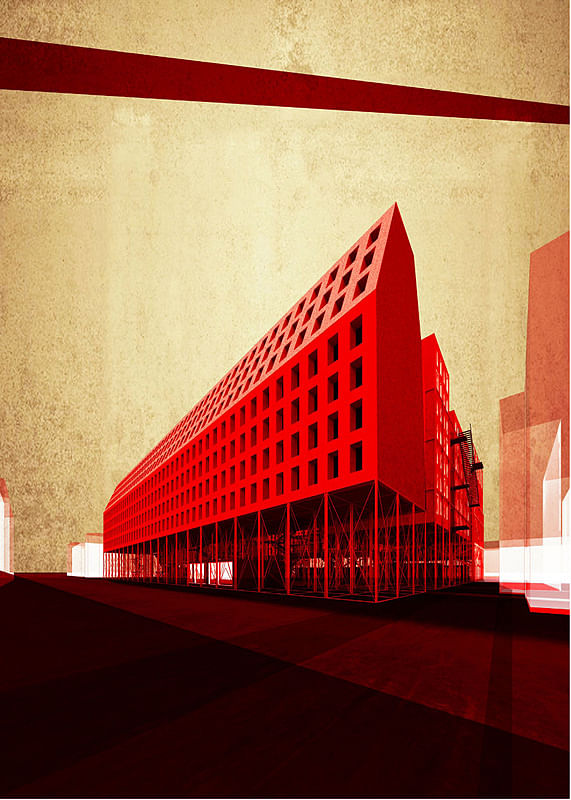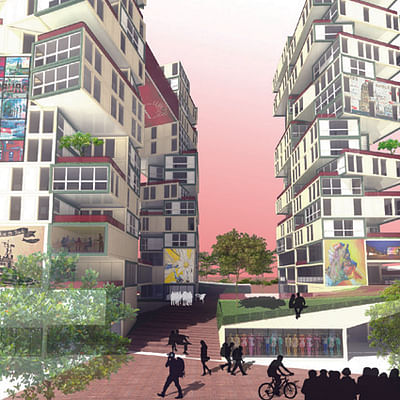The winning Hamburg Hybrid Housing ideas
By Bustler Editors|
Monday, Dec 21, 2015

Related
CTRL+SPACE launched the Hamburg Hybrid Housing competition to explore the ongoing search for feasible housing solutions, as major cities including London, New York, Tokyo, and — in this case — Hamburg continue to change. The competition also questions how increasing urban density can benefit urban planning and housing design.
Participants worldwide proposed housing concepts that can produce tangible improvements in Hamburg's neighborhoods, as well as other cities. At the end of the competition, the jury picked three prize winners and seven honorable mentions.
Scroll down to check 'em out.
FIRST PRIZE: “We are here to stay”
by Gabriele Filippi | Genova, Italy




Jury comment: "This proposal was commended by the Jury as a true embodiment of the spirit of the location of St. Pauli, a struggling, rebellious, unconventional neighborhood. Being clearly an architectural response to all recent history of the location and the city, the different elements that constitute the whole complex are reactive of the urban surroundings, whether in scale or configuration.
The fragmented and heterogeneous approach is justified by the multitude of environments the projects wishes to generate, always confronting private life and public use. A strong emphasis is placed with providing public spaces of different characters and expressions to the use of its visitors, in the inner square, the intermediate level, terraces and rooftops. The hybridity of the building comes from all the bridges established with the city fabric, either concrete or metaphorical; the building is open and accessible to the generality of public in all its public spaces.
Structure takes here an important presence, the exoskeleton enforces the unfinished quality of the space, apart from introducing a strong graphical appeal. It harmonizes with the dynamics of Spielbudenplatz and features a series of transparent moments that support the physical permeability between the building and the city. Harnessing the qualities of its environment and gathering the essential ingredients of the city, this project constitutes a city within the city, permeable to the outside, providing a framework to urban activities, placemaking as a process and a underlining philosophy."
SECOND PRIZE: "Little Hamburg Hybrid Housing”
by Michal Sapko | Lublin, Poland



Jury comment: "Exceptional project that successfully responds to the conditions of the Intervention Site, with an easiness that humbles the complexity of the assignment. Constituted by two opposing directions that are the materialization of the two driving forces of the project: an horizontal block that touches the ground and hosts all the public functions and a vertical set of buildings which answer to the Residential requirements.
In the meeting point of this stratified program resides a strong element of the proposal, a community terrace that provides an open playground for all the semi-public activities related to the health and wellness of the residents. The vertical stratification of the Program reflects the distribution of the individual units in towers that react in density and height to the surrounding urban elements.
A degree of sustainability is introduced by the question of energy production, all this exterior surface is used as solar collectors in an attempt to take benefit from the location and orientation of the building. An airy project, an elegant and innovative reflection on how to increase density in the city center."
THIRD PRIZE: "GEODE”
by Jeremie Parent and Maude Beaupre from Quebec, Canada



Jury comment: "This project was praised by the Jury as an interesting reinterpretation of the theme of the Agricultural City. The communitarian spaces revolve around the agricultural activities to fruitfully engage with the surrounding neighborhood. This project brings also into consideration the present proliferation of productive spaces in the city as well the importance of food independence as an activity related to the needs of shelter.
Formally, the Geode theme allows a variation from the stern exterior face to the more diverse interior; from the outside the identification as a single building, from the interior an identification of the individual residential cells. The Residential Sector floats above the public space, promoting wider views, visual permeability and a differentiated environment regarding that of Spielbudenplatz.
The public space is comprised of a hard and soft arable topography which houses underneath all the Commercial facilities. Inside the Residential modules the agricultural production theme is still present; all units have protruding greenhouses that apart from functional are able to introduce a phenomenological aspect with their shines and reflections. An interesting take on economic and ecological sustainability of food production and its integration in the architecture of the place."
Images courtesy of CTRL+SPACE.
Find the honorable mentions in the gallery below.








Share
0 Comments
Comment as :